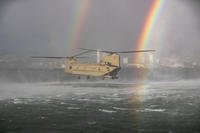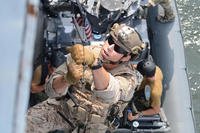Situated just 20 miles from Seattle, Naval Base Kitsap houses America's most powerful and secret deterrents, a weapon that is the first line of defense for U.S. national security: U.S. Navy dolphins.
Since 1967, the Navy has been training dolphins and sea lions (and probably other marine life) for military applications such as mine clearing, force protection and recovery missions. The U.S. Navy Marine Mammal Program deployed military dolphins as early as the Vietnam War and as recently as the 2003 U.S.-led invasion of Iraq.
When protecting harbors and ships from mines, as they do at Naval Base Kitsap, the dolphins use their extraordinary biological sonar to detect hazards beneath the surface, whether tethered to the sea floor or buried beneath sediment.
If a mine or other weapon is detected, the dolphin returns to its handler, who gives the animal a buoy to mark the location of the device on the surface. Passing ships know to avoid these markers while Navy explosives ordnance disposal divers neutralize the threat below.
For protection against enemy divers, dolphins will swim up to the infiltrator, bump into them and place a buoy device on their back or a limb, using their mouth. The buoy then drags the outed diver to the surface for easy capture. When trained sea lions perform the same maneuver, they use a kind of handcuff with their mouths to attach the buoy.
Since Bangor, Washington, now houses the largest single nuclear weapons site in the world, it needs protection from all sides, including the seaward side. That's where the Navy's dolphin pods and sea lions come in. Navy spokesman Chris Haley says the animals have been defending the waters around the stockpile, holding roughly 25% of the United States’ 9,962 nuclear warheads, since 2010.

The United States isn't the only country known to train marine animals for these kinds of missions. Its sea mammal mission only became public knowledge in the 1990s, however. The Soviet Union trained dolphins for similar harbor protection.
After the fall of the USSR, the program was said to be in limbo, and the Soviet-trained dolphins are believed to have been sold to Iran in 2000. Russia is said to have been looking to update its training program, and may even have used them in Syria.
Read: Iran May Have a Fleet of Communist Killer Dolphins
Satellite imagery near the North Korea city of Nampo has revealed what look to be dolphinariums in the Taedong River, meaning North Korea may have a dolphin-based anti-infiltration plan of its own.
-- Blake Stilwell can be reached at blake.stilwell@military.com. He can also be found on Twitter @blakestilwell or on Facebook.
Want to Learn More About Military Life?
Whether you're thinking of joining the military, looking for fitness and basic training tips, or keeping up with military life and benefits, Military.com has you covered. Subscribe to Military.com to have military news, updates and resources delivered directly to your inbox.















